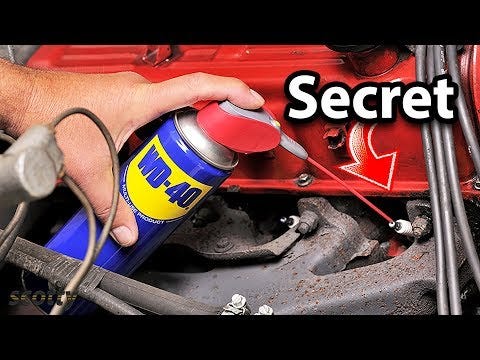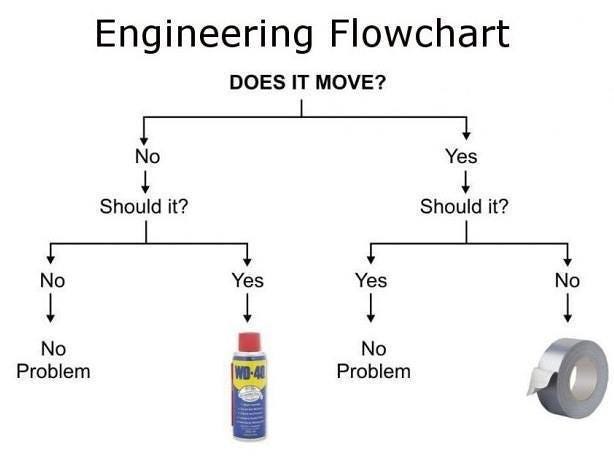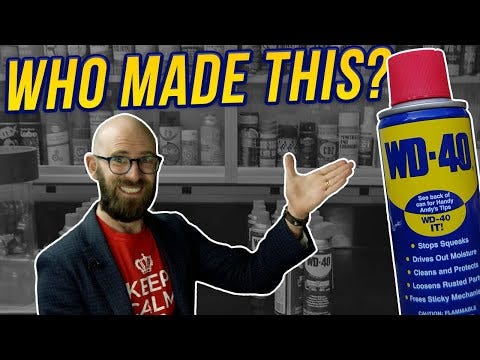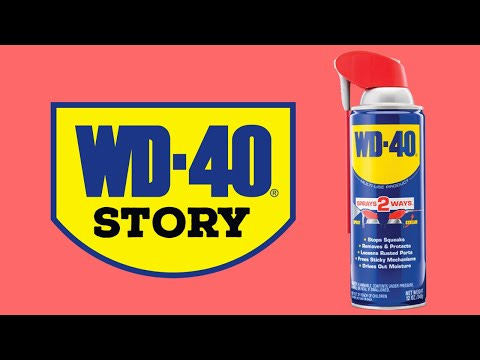WD 40 and the Cult of Fixing Things
I know what you’re thinking.
She’s writing about WD 40?
Yes. WD 40. Why?? Ok, but hear me out.
I was sitting in the kitchen one night, coffee gone cold, laptop open but brain closed.
On the counter sat a can of WD 40.
Not in the toolbox. Not in the garage. Just there.
Like it had migrated on its own and decided this was home now.
The blue and yellow label caught the light from the fridge.
It looked confident. Too confident for a can that’s basically oily water.
I picked it up and realised I had no idea what was actually inside it.
So I looked it up, half out of boredom and half to prove that I use the internet for useful things sometimes.
That’s when I fell down a rabbit hole, starting with rocket engineers and ending with marketing geniuses, brand cults and people spraying their shoes with petroleum.
What I found out
WD stands for Water Displacement and the 40? The 40 refers to the fact that they messed it up 39 times before getting it right.
According to the brand’s own history page the Rocket Chemical Company in San Diego developed the formula in 1953 to protect the outer skin of the Atlas missile from rust and corrosion. The formula worked so well that workers began sneaking cans home.
A product built for missiles ended up in household drawers.
Brilliant.
Who invented it? Depends who you ask. The company honours Norman B. Larsen for marketing it it as an aerosol.
Historian Iris Engstrand points to chemist Iver Norman Lawson, who sold the formula for 500 dollars.
Five hundred dollars for one of the most successful consumer formulas ever! Let that sink in.
What’s actually inside
No secret NASA compound. No alchemy. Just hydrocarbons, light petroleum oils and some CO₂.
The Safety Data Sheet lists them openly.
It’s basically oil in a spray-can pretending to be a miracle.
But the trick is in how it works. It seeps into joints, displaces water and leaves a film that makes you feel like you know what you’re doing.
Which… in the world of DIY is half the battle.
How a tool became a cult
WD 40 could have stayed boring. Instead, it went mythic.
In the 90s the company asked users what weird fixes they used the spray for.
They ended up with a public list of 2000+ Uses that ranges from the legit (rusty bolt) to the absurd (gum removal).
There’s even a legend about a tuna-boat engine dunked in salt water, sprayed and revived.
Today I Found Out couldn’t verify it, but the myth lives on.
People don’t buy a lubricant. They buy the fantasy that anything stuck in their life can be freed with enough spray.
From rocket fuel to pop culture
By the time Hank Hill in King of the Hill said “Give me a tap and die and some WD 40 and you can fix just about anything,” the product was cultural shorthand.
Then art collective MSCHF launched Smells Like WD 40, an industrial-fragrance parody that actually sold out.
WD 40 didn’t sue. They reposted it and laughed along.
When your brand laughs at being memed, you’ve already won.
Their YouTube channel feels like ASMR therapy for people who like control: rusty hinges, slow motion sprays, satisfying fixes.
WD 40 in action: the internet’s most determined problem solver
Sometimes the marketing team doesn’t even need actors. The product does the drama.
1. The squeaky hinge classic
2. The stuck-zipper redemption
3. The car-guy gospel

4. The myth of the can
The fine print nobody reads
Here’s the twist. WD 40 isn’t technically a lubricant.
Or a cleaner.
It’s kind of both, but it isn’t great at either.
The company even admits it can damage rubber and some plastics if mis-used.
That’s why they launched WD 40 Specialist: a sub-brand for people who finally read labels.
Black cans, words like Silicone or Dry Lube or Degreaser.
Feels like perfume ads for mechanics.
It’s a perfect feedback loop:
Sell everyone a universal fix. Watch them misuse it. Then sell the special version to fix their misuse.
Problem, solution, correction kit.
Capitalism at its finest.
“WD 40 fixes everything.”
Until it doesn’t. Then WD 40 fixes that, too.
And the best part?
The same people who bragged about using the blue can for everything now say: “No no, I only use Specialist. I’m not a rookie.”
The cult upgraded.
It’s genius.
The fix for overusing WD 40 is still … more WD 40.
The WD 40 playbook
Solve a boring problem completely.
Rust isn’t glamorous. Reliability is.
Name the job, not the dream.
“Water Displacement 40” sounds like a lab label. A clear, functional name builds trust – That’s why it sticks.
Turn your origin story into folklore.
Tell your “garage moment.” People love the myth of persistence: Forty tries, one win.
Let your fans write the script.
“2000 uses” is crowd-sourced mythology. User stories build credibility faster than any ad.
Laugh at yourself.
If someone memes your product and you repost it, you’ve achieved something.
Build your upgrade path.
Start general. Move specialist. Keep people buying.
Admit your limits.
Transparency beats perfection. Say what you don’t do and people will trust what you do.
Reality check
WD 40 is petroleum based, flammable, and about as sustainable as a lawnmower running on nostalgia.
It leaks a bit, smells industrial and sits proudly on shelves while the world is melting.
That’s the uncomfortable truth.
The can people call a “lovebrand” is still built on fossil fuel.
It shouldn’t work in 2025, yet it does.
Maybe because humans are sentimental hypocrites.
Maybe because we like things that make us feel capable, even when they aren’t clean.
WD 40 doesn’t promise ethics. It promises control.
Takeaway
WD 40 isn’t just a spray can. It’s a mirror.
We like to think we’ve evolved past the petroleum age, yet we still worship the things that make us feel capable. We reward reliability, even when it’s built on oil. Function will always beat ethics, as long as the story feels good enough. Maybe that’s what keeps the can on the shelf.
It works, and we’d rather not ask ourselves why.
Catch you next time,
The Orbit









